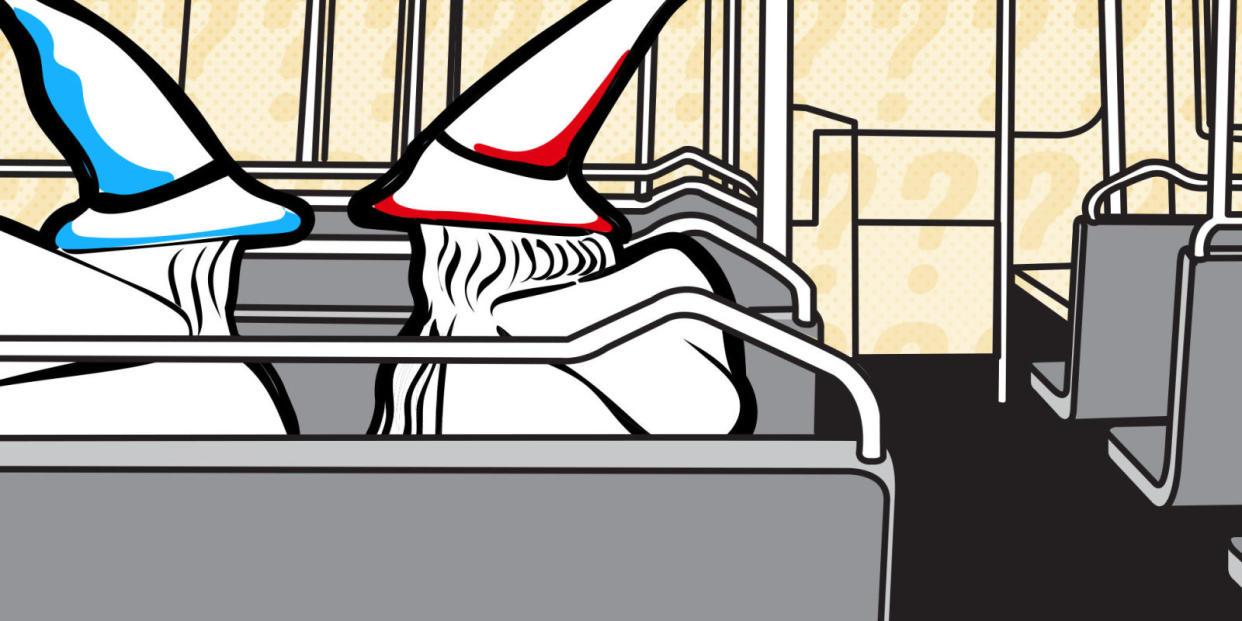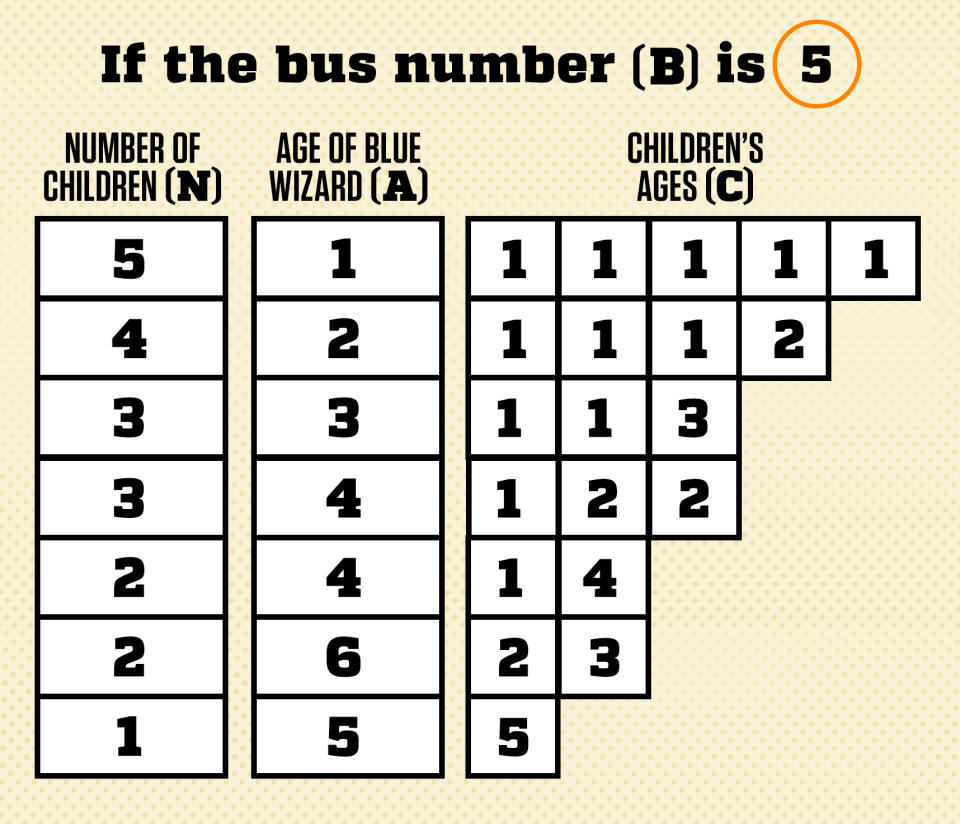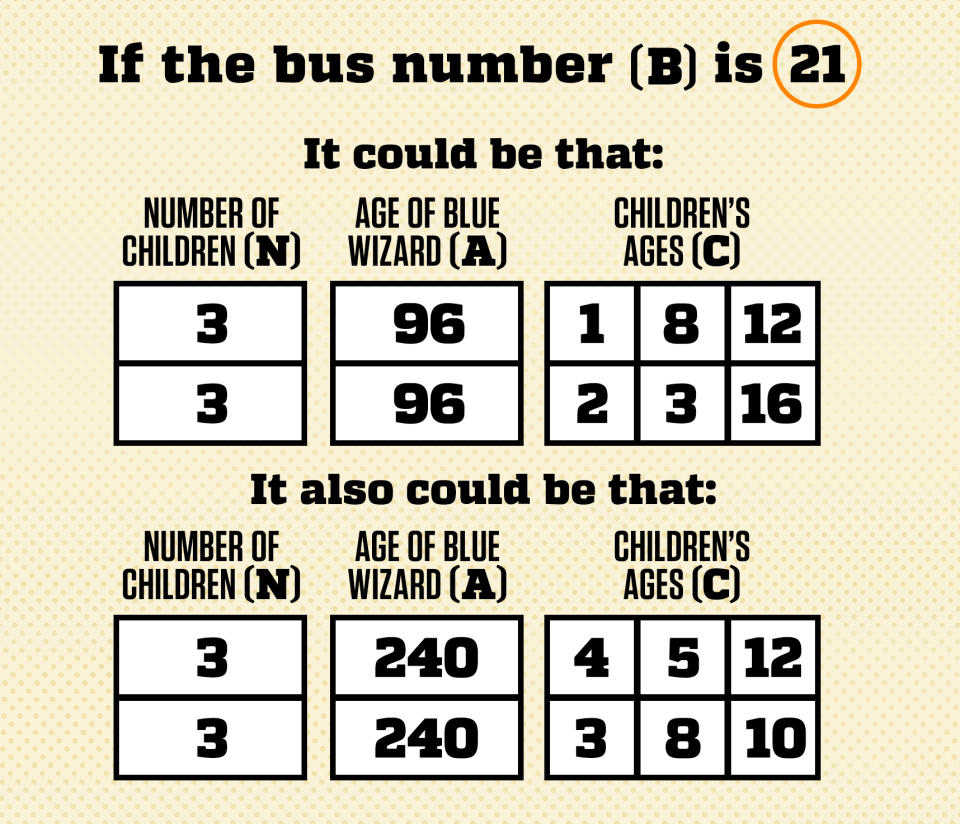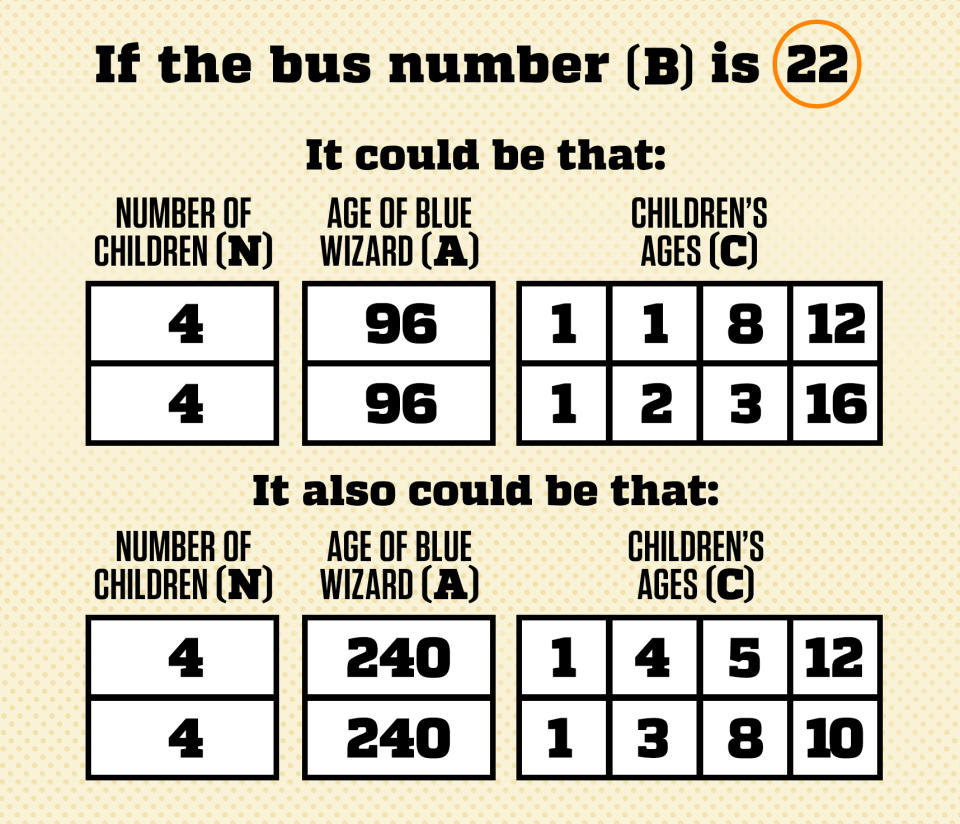Solution to Riddle of the Week #34: Two Wizards Ride a Bus

Solving this puzzle requires patience and a lot of factoring. You can eventually arrive at the answer by simply testing random numbers, but once you start calculating a few scenarios there are some patterns that emerge.
You can see the original question here.
Solution
[The bus number is at the bottom of this post, scroll down to see the straight answer.]
Based on the question, we can say that if the Blue Wizard told the Red Wizard his age and the number of his children, then the Red Wizard could not deduce the individual ages of the Blue Wizard's children. That is the piece of information that allows the Red Wizard to ascertain the Blue Wizard's age. The fact that the Red Wizard can figure out the Blue Wizard's age will allow us to discover the bus number. And remember, the Red Wizard does know the bus number.
There is another piece of information hidden here: that the Blue Wizard must have at least three children. If he had one child, the age of that child would be both the bus number and his wizard father's age. Unlikely, but he is a wizard, and this is a riddle, so perhaps the solution is a bizarre age. Perhaps the wizard is hundreds of years old. But the real reason it cannot be true in the riddle is because the Blue Wizard could not have responded: "No, you could not."
Here is the relevant exchange again:
Red Wizard: Perhaps if you told me your age and the number of your children, I could work out their individual ages?
Blue Wizard: No, you could not.
If the number of children is one, then the Red Wizard could work out that child's age. The same is true for two children. Knowing the Blue Wizard's age (the product of the children's ages), the number of children, and the bus number (the sum of the children's ages), the Red Wizard could work out the individual ages of the children every time if there were only two. So there must be three children or more.
Because the Blue Wizard said "No, you could not," we know that the age of the Blue Wizard (A), the number of children (N), and the bus number (B) cannot be used by the Red Wizard to determine the children's ages (C). This means that there must be multiple possible combinations of the Blue Wizard's number of children (N) and those children's ages (C) that multiply to equal the age of the Blue Wizard (A).
To summarize, we know that A, N, and B cannot be used to determine C. In addition, we know that there must be multiple possibilities for N and C that would give us the same number for A.
Now we need to start crunching some numbers. Let's start with the number we are looking for, the bus number (B), and work backward from there.
Say the bus number (B) is 5. In this case, it's possible that the Blue Wizard has 5 children who are each 1 year old, making him 1 year old as well (again, we are suspending disbelief to just look at the numbers). Of course, there are more combinations if the bus number is 5. Let's jot them all out.

If the bus number (B) were 5, the age of the Blue Wizard (A) and the number of children (N) could be used by the Red Wizard to determine the children's ages (C). So the bus number cannot be 5.
Let's look at a higher number. Say the bus number (B) is 21. In this case, the Blue Wizard could have responded, "No, you could not," because his age (A) and number of children (N) cannot necessarily be used to determine the children's ages (C). But there is another reason 21 cannot be the bus number (B). Let's look at some possibilities if bus number (B) is 21.

As we can see, not only are their multiple possible combinations of children's ages (C) (which is what we are looking for, because of the "No, you could not" response), but it also would be impossible to determine the age of the Blue Wizard (A) if the bus number (B) were 21. It could be either 96 or 240. But the Red Wizard figures out the Blue Wizard's age, so this can be the solution.
Let's see what happens when we change the bus number (B) to 22.

Here we find something interesting. By increasing the bus number (B) by one, we can keep the possible wizard ages the same by adding one more child whose age is one. Adding the extra one increases the bus number, but it does not change the wizard's age, the product of his children's ages. This means that you could simply keep adding children with the age of one to increase the bus number, and the Blue Wizard will always have multiple possible ages. Therefore, the bus number must be lower than 21. We also know that the bus number must be higher than 5, so now it is just a matter of finding the right one.
Answer
The number of the bus is 12. This is the only bus number where the age of the Blue Wizard (A) and the number of children (N) cannot be used to determine the children's ages (C), and there is only one possible age of the Blue Wizard (A), so the Red Wizard can finally, at long last, determine his companion's age. The Blue Wizard must be 48, and his children's ages could be 2, 2, 2, and 6, or possibly, 1, 3, 4, and 4.
For more on this riddle, and an even more difficult version, check out MIT lecturer Tanya Khovanova's paper on the problem here. And make sure to come back next week for another riddle!
*See all of our riddles here.
You Might Also Like


